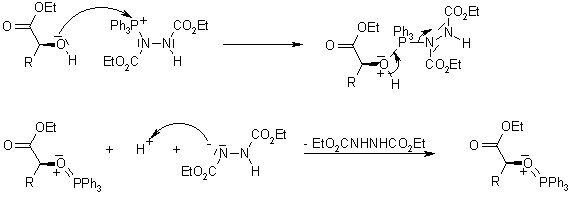Mitsunobu Reaction


The Mitsunobu Reaction allows the conversion of primary and secondary alcohols to esters, phenyl ethers, thioethers and various other compounds. The nucleophile employed should be acidic, since one of the reagents (DEAD, diethylazodicarboxylate) must be protonated during the course of the reaction to prevent from side reactions.
Suitable nitrogen nucleophiles include phthalimide or hydrogen azide; subsequent hydrolysis (in the case of using phthalimide, see Gabriel Synthesis) or selective reduction (in the case of azide formation, see Staudinger Reaction) makes the corresponding amines accessible.
Mechanism of the Mitsunobu Reaction
The triphenylphosphine combines with DEAD to generate a phosphonium intermediate that binds to the alcohol oxygen, activating it as a leaving group. Substitution by the carboxylate, mercaptyl, or other nucleophile completes the process.


The reaction proceeds with clean inversion, which makes the Mitsunobu Reaction with secondary alcohols a powerful method for the inversion of stereogenic centers in natural product synthesis.

Side Reaction:

New protocols have been developed which allow better removal of side products and/or the conversion of more basic nucleophiles.
Recent Literature
Mitsunobu Reaction with 4-(Diphenylphosphino)benzoic Acid: A Separation-Friendly Bifunctional Reagent that Serves as Both a Reductant and a Pronucleophile
Easily Prepared Azopyridines As Potent and Recyclable Reagents for Facile Esterification Reactions. An Efficient Modified Mitsunobu Reaction
Systematic Evaluation of 2-Arylazocarboxylates and 2-Arylazocarboxamides as Mitsunobu Reagents
Mitsunobu Approach to the Synthesis of Optically Active α,α-Disubstituted Amino Acids
One-Carbon Homologation of Primary Alcohols to Carboxylic Acids, Esters, and Amides via Mitsunobu Reactions with MAC Reagents
Fluorous Mitsunobu reagents and reactions
A convenient Two-Step Procedure for the Synthesis of Substituted Allylic Amines from Allylic Alcohols
Use of Sonication for the Coupling of Sterically Hindered Substrates in the Phenolic Mitsunobu Reaction
Organocatalytic Mitsunobu Reactions
Carbon Nucleophiles in the Mitsunobu Reaction. Mono and Dialkylation of Bis(2,2,2-trifluorethyl) Malonates
O-TBS-N-tosylhydroxylamine: A Reagent for Facile Conversion of Alcohols to Oximes
An Efficient, One-Pot Synthesis of S-Alkyl Thiocarbamates from the Corresponding Thiols Using the Mitsunobu Reagent
Synthesis of N-H vinylaziridines: a comparative study
Exploration of the Mitsunobu Reaction with Tosyl- and Boc-Hydrazones as Nucleophilic Agents
Single-Step Process for the Reductive Deoxygenation of Unhindered Alcohols
Conversion of Alcohols, Thiols, Carboxylic Acids, Trimethylsilyl Ethers, and Carboxylates to Thiocyanates with Triphenylphosphine/Diethylazodicarboxylate/NH4SCN
Successive Nucleophilic and Electrophilic Allylation for the Catalytic Enantioselective Synthesis of 2,4-Disubstituted Pyrrolidines
A Modular Synthesis of 2-Alkyl- and 2-Arylchromans via a Three-Step Sequence



















No comments:
Post a Comment